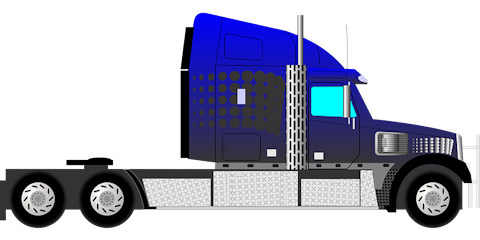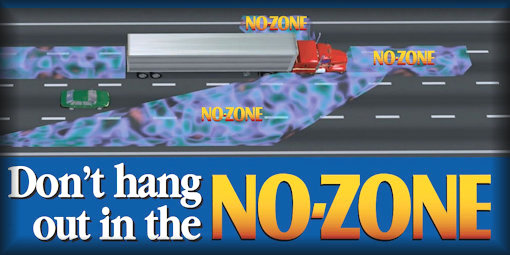

Mobile users:
For best results, view in Landscape mode.
Exit
behind trucks.
Slowing down and exiting or turning behind a truck, or any
other vehicle won't increase your drive time by more than
a few moments.
Speeding up to make it to an exit first might save
you a few seconds, but that action increases the
probability of an accident.
It may
force you to cut off the other driver, removing
his or her cushion of
safety - and your own.
Always
pass a truck on the left side:
Passing any vehicle - especially a
truck, on the right
is like
asking for an accident.
When passing, look for the
front of the truck in your rear-view
mirror before pulling in front and avoid braking situations.
Trucks and buses take much
longer to stop in comparison to cars.
If you force a larger vehicle such as a bus or truck, to
stop quickly
this could cause a serious, even fatal accident.
Be careful of trucks making
wide right turns.
If you try to get in between the truck and
the curb, you'll be caught in a "squeeze"
and can suffer a serious accident.
Truck drivers sometimes need to swing wide to the left in
order to safely negotiate a right turn especially in the
city.
They can't see cars
directly behind or beside them.
Cutting in between the truck and the curb increases the
possibility of a crash.
So pay attention to truck signals, and give them lots of
room
to maneuver.
Realize
that large vehicles may be moving
faster than they appear:
Many accidents occur
at intersections because a car driver
underestimates
the speed of an approaching truck.
When a
truck passes you, stay to the right and slow down
just a little.
Truckers often do this when
they are being passed.
It helps the
passing vehicle to complete the pass safely.
Never
speed up when a tractor-trailer passes as this can cause
a very dangerous situation, especially in heavy traffic.
Oncoming trucks:
If there is an oncoming truck approaching
you on a two-lane
highway, it is a very good idea to keep
to the right side of your
lane and slow down a little.
This
will help avoid the chance of a sideswipe, and also reduce
the effect of the wind turbulence as the truck passes you.
Remember wind turbulence pushes vehicles apart, not
together.
Respect a trucker's blind spots:
Many
motorists falsely assume that truckers can see
the road better
because they sit twice as
high as the driver of a car.
While truckers do enjoy a
better forward view and have bigger
mirrors, they still have serious
blind spots.
A car
can disappear from view up to 20 feet in front of the cab,
on either side of the tractor-trailer (particularly
alongside
the cab),
and up to 200 feet in the rear.
Remember
that if you can't see the truck driver
in his or her side mirror, the driver can't see you.
Don't
tailgate:
Tailgating takes away your own cushion of
safety.
Never
follow a truck too closely.
Not only are you not visible to the truck driver, your
view ahead
is also blocked by the rear of the trailer.
If you
cannot see the trucker's side mirrors,
they can't see you.
You are
now traveling too close, so slow down to maintain a
cushion of safety between you and the truck ahead.
A
greater response time is needed to maneuver around any large
vehicle such as a tractor-trailer.
Other hazards include tire blowout or flying debris
stirred up on the
roadside by the truck.
Be careful near weigh stations:
Trucks will be slowing down
when entering or exiting weigh stations.
They will
also be traveling slow when reentering the highway from
weigh stations.
Always be extra alert when near these areas.
Observe
a truck's turn signals:
Due to the length of their vehicles,
tractor-trailer drivers must often
swing out to the left as the
first step in making a right turn.
The
average tractor-trailer is
65' feet in length, and weighs
40,000 lbs.
to brake, and to change lanes.
A loaded tractor-trailer that is traveling 55 miles per hour may need
up to 430 feet to come to a complete stop.
A passenger car needs less than 200 feet to do the same.
And a car can complete a lane change in mere seconds, while
a trucker must employ a more detailed and time consuming
lane change process.

Watch the Blind Spots -
The "NO-ZONES"

Trucks have blind
spots, or No-Zones, around the front,
back and sides of the truck.
Watch out!
A truck could even turn into you, because these No-Zones
make it difficult for the driver to see.
So, don't hang out in
the No-Zones, and remember,
if you can't see the truck driver in the truck's
mirror, the truck driver can't see you.

.
